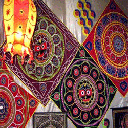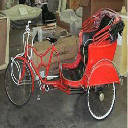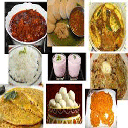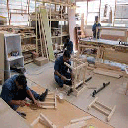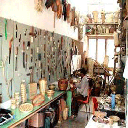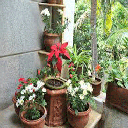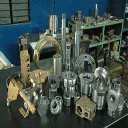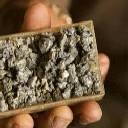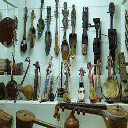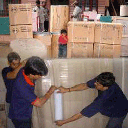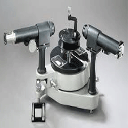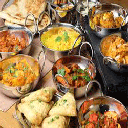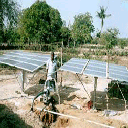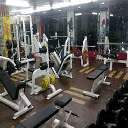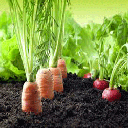Haryana is a prosperous land whose hard-working people have made it an area of agricultural and industrial plenty.it’s the state in north India It is bordered by Punjab and Himachal Pradesh to the north, and by Rajasthan to the west and south. The river Yamuna defines its eastern border with Uttarakhand and Uttar Pradesh. Haryana also surrounds Delhi on three sides, forming the northern, western and southern borders of Delhi. Consequently, a large area of Haryana is included in the National Capital Region. The capital of the state is Chandigarh which is administered as a union territory and is also the capital of Punjab. aryana was the cradle of the Indus Valley and Vedic Civilizations, both flourishing on the banks of the now lost Sarasvati River. Several decisive battles were fought in the area, which shaped much of the history of India. These include the epic battle of Mahabharata at Kurukshetra (including the recital of the Bhagavad Gita by Krishna), and the three battles of Panipat. Haryana was administered as part of the Punjab province of British India, and was carved out on linguistic lines as India's 17th state in 1966. Haryana is now a leading contributor to the country's production of foodgrain and milk. Agriculture is the leading occupation for the residents of the state, the flat arable land irrigated by submersible pumps and an extensive canal system. Haryana contributed heavily to the Green Revolution that made India self-sufficient in food production in the 1960s The climate of Haryana is similar to other states of India lying in the northern plains. It is very hot in summer (up to a high of 50 deg Celsius) and cold in winters (down to a low of 1 deg Celsius). The hottest months are May and June and the coldest being December and January. Rainfall is varied, with the Shivalik Hills region being the wettest and the Aravali Hills region being the driest. Haryanavi has traditionally been the dominant language spoken by the martial people of Haryana.punjabi is also spoken by a lot of people in Haryana especially by those Hindus and Sikhs who came over from Pakistan. Punjabi is second official language of Haryana. Haryana is one of the leading states in sports and has produced some of the best Indian players in a variety of games. In 2010 Delhi Commonwealth Games 22 out of 38 Gold Medals came from Haryana
Haryana having the Rock Garden, Sukhna Lake, Govt. Museum & Art Gallery Haryana is Known as the 'Cradle of Modern Civilization', Haryana has a religious identity of its own. The doctrine of 'Bhagwad Gita', the epic of 'Mahabharata' and the presence of now subterranean river Saraswati and temples scattered around Kurukshetra have been attracting pilgrims to this state, throughout the year. Birla Gita Mandir, Sheetala Mata Mandir, Mansa Devi Temple are some of the few Hindu worship Tamples. Baba Rameshwar Dass Temple,Birla Gita Mandir,Mansa Devi Temple,Sheetala Devi Templ, Shiv Temple (Bagot), Sita Mai Temple,Sthaneshwar Mahadev Temple. Thanesar:It’s is located at district Kurukshetra The very old site, known as Raja Harsh-ka-Tila, is a wide mound approximately 1 km long and 750 m wide. The height of the mound is about 15 to 18 m from the surrounding area. Excavations here have revealed a sequence of cultures, which ranges from the Kushana to the Mughal period. A few painted 'Grey Ware' shreds were found in the pre-Kushana levels. The site was equipped from the Kushana to the Mughal period. The major discovery of post- Gupta period is represented by brick structures associated with 'Red Polished Ware'. Structural remains along with antiquities of the Indo-Islamic period were also exposed, including a Mughal period garden complex on the Charbagh pattern. Ballabgarh: has a rags-to-riches story to it. Its founder, Ballab Singh, was an extremely poor farmer who became a millionaire overnight when he discovered two mules laden with gold on his tiny farm. For the next seven generations he and his successors controlled over 200 villages. The last of this family was Nahar Singh who became a martyr in the Uprising of 1857. Palwal: Situated about 64kms from Delhi on the Delhi-Mathura highway, Palwal used to be a part of the Pandava kingdom of Indraprastha. During the early days of their exile, the Pandavas are reported to have dug in here for about three months. They later gave it special importance in the kingdom. However, the town decayed but later Raja Vikramaditya restored the ruins to their former glory. Mahatma Gandhi was arrested from here by the British Government on April 9, 1919, and the Gandhi Ashram stands as a quiet reminder of his efforts against the Britishers. The Panchayati temple is again the Pandavas doing. An old, ruined Mughal fort stands guard over the town while a Jama Masjid built around early 13th century and the shrines of Shihabuddin and Roshan Chirag are other places to see. Rani Ki Chhatri :Another monument of historical significance continues to be in a state of neglect. Rani Ki Chhatri, a small but beautiful palace built by Raja Balram for his queen. In the days of yore the palace was a symbol of architectural excellence, interspersed with a bathing tank, fountains and water courses, was frequented by the royal ladies. Yamunanagar district is the largest industrial town wholly within in Haryana. It has Asia's largest paper mill BILT and Asia's largest Sugar Mill. Yamunanagar has Asia's largest timber industry, an HPGCL thermal power plant, a hydro power plant and India's largest Railway workshop. It is also famous for its old steel and brass industry. Faridabad is another big industrial part of Haryana. It is home to hundreds of large scale companies like Orient Paper & Industries, JCB India Limited, Nirigemes, Agri Machinery Group (Escorts Limited), India Yamaha Motor Pvt. Ltd., Whirlpool, ABB Group, Goodyear Tyres and Knorr Bremse India Pvt. Ltd. There are thousands of medium and small scale units as well, like Amrit Enterprises, McAma Industries. Panipat is a city of textiles and carpets. It is the biggest centre for cheap blankets and carpets in India and has a handloom weaving industry. The pickle "Pachranga International" is also well known. Panipat also has heavy industry, with ASIA's SECOND BIGGEST refinery of the Indian Oil Corporation, a National Thermal Power Corporation power plant, National Fertilizers Limited plant, [INDIA"s Biggest Naptha Cracker Plant]and PROPOSED [STYRENE BUTADINE RUBBER PLANT] Hissar is another big city where Jindal company has established. Jindal Steel now increasing their business and open new factory in other state also.


